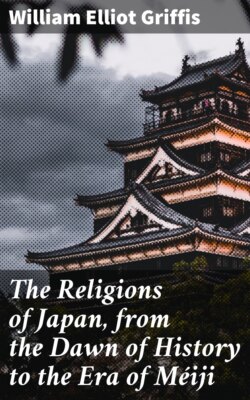Читать книгу The Religions of Japan, from the Dawn of History to the Era of Méiji - William Elliot Griffis - Страница 23
На сайте Литреса книга снята с продажи.
The Japanese a Young Nation.
ОглавлениеTable of Contents
What impresses us in the study of the history of Japan is that, compared with China and Korea, she is young. Her history is as the story of yesterday. The nation is modern. The Japanese are as younger children in the great family of Asia's historic people. Broadly speaking, Japan is no older than England, and authentic Japanese history no more ancient than British history. In Albion, as in the Honorable Country, there are traditions and mythologies that project their shadows aeons back of genuine records; but if we consider that English history begins in the fifth, and English literature in the eighth century, then there are other reasons besides those commonly given for calling Japan "the England of the East."
No trustworthy traditions exist which carry the known history of Japan farther back than the fifth century. The means for measuring and recording time were probably not in use until the sixth century. The oldest documents in the Japanese language, excepting a few fragments of the seventh century, do not antedate the year 712, and even in these the Chinese characters are in many instances used phonetically, because the meaning of the words thus transliterated had already been forgotten. Hence their interpretation in detail is still largely a matter of conjecture.
Yet the Japanese Archipelago was inhabited long before the dawn of history. The concurrent testimony of the earliest literary monuments, of the indigenous mythology, of folk-lore, of shell-heaps and of kitchen-middens shows that the occupation by human beings of the main islands must be ascribed to times long before the Christian era. Before written records or ritual of worship, religion existed on its active or devotional side, and there were mature growths of thought preserved and expressed orally. Poems, songs, chants and norito or liturgies were kept alive in the human memory, and there was a system of worship, the name of which was given long after the introduction of Buddhism. This descriptive term, Kami no Michi in Japanese, and Shin-t[=o] in the Chinese as pronounced by Japanese, means the Way of the Gods, the t[=o] or final syllable being the same as tao in Taoism. We may say that Shint[=o] means, literally, theoslogos, theology. The customs and practices existed centuries before contact with Chinese letters, and long previous to the Shint[=o] literature which is now extant.
Whether Kami no Michi is wholly the product of Japanese soil, or whether its rudimentary ideas were imported from the neighboring Asian continent and more or less allied to the primitive Chinese religion, is still an open question. The preponderance of argument tends, however, to show that it was an importation as to its origin, for not a few events outlined in the Japanese mythology cast shadows of reminiscence upon Korea or the Asian mainland. In its development, however, the cultus is almost wholly Japanese. The modern forms of Shint[=o], as moulded by the revivalists of the eighteenth century, are at many points notably different from the ancient faith. At the World's Parliament of Religions at Chicago, Shint[=o] seemed to be the only one, and probably the last, of the purely provincial religions.
In order to gain a picture of life in Japan before the introduction of Chinese civilization, we must consult those photographs of the minds of the ancient islanders which still exist in their earliest literature. The fruits of the study of ethnology, anthropology and archaeology greatly assist us in picturing the day-break of human life in the Morning Land. In preparing materials for the student of the religions of Japan many laborers have wrought in various fields, but the chief literary honors have been taken by the English scholars, Messrs. Satow,1 Aston,2 and Chamberlain.3 These untiring workers have opened the treasures of ancient thought in the Altaic world.4
Although even these archaic Japanese compositions, readable to-day only by special scholars, are more or less affected by Chinese influences, ideas and modes of expression, yet they are in the main faithful reflections of the ancient life before the primitive faith of the Japanese people was either disturbed or reduced to system in presence of an imported religion. These monuments of history, poetry and liturgies are the "Kojiki," or Notices of Ancient Things; the "Manyöshu" or Myriad Leaves or Poems, and the "Norito," or Liturgies.
